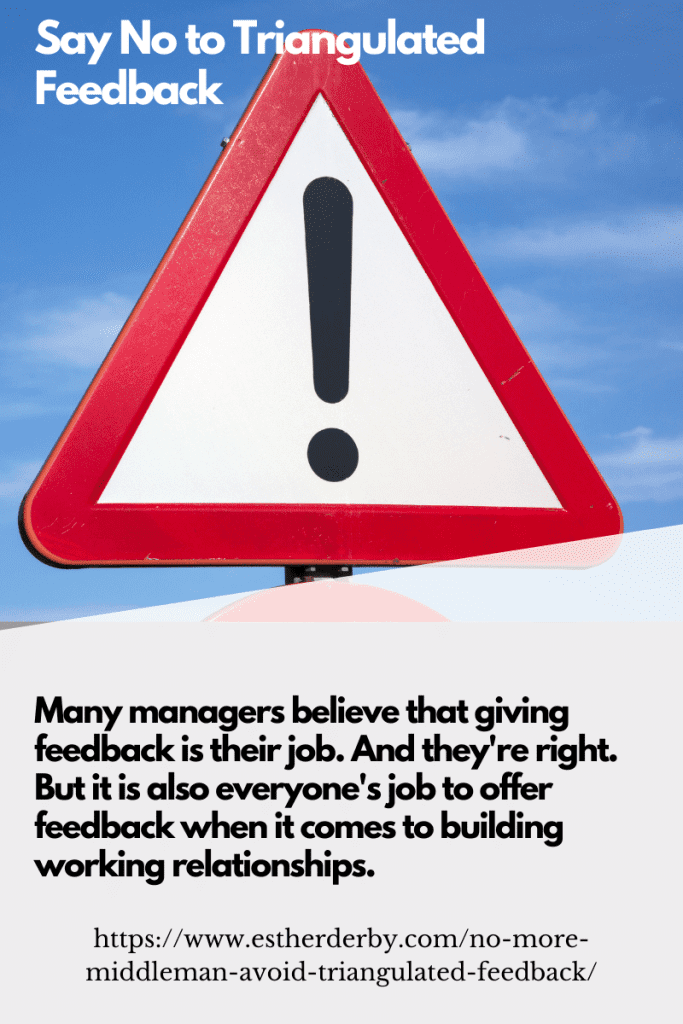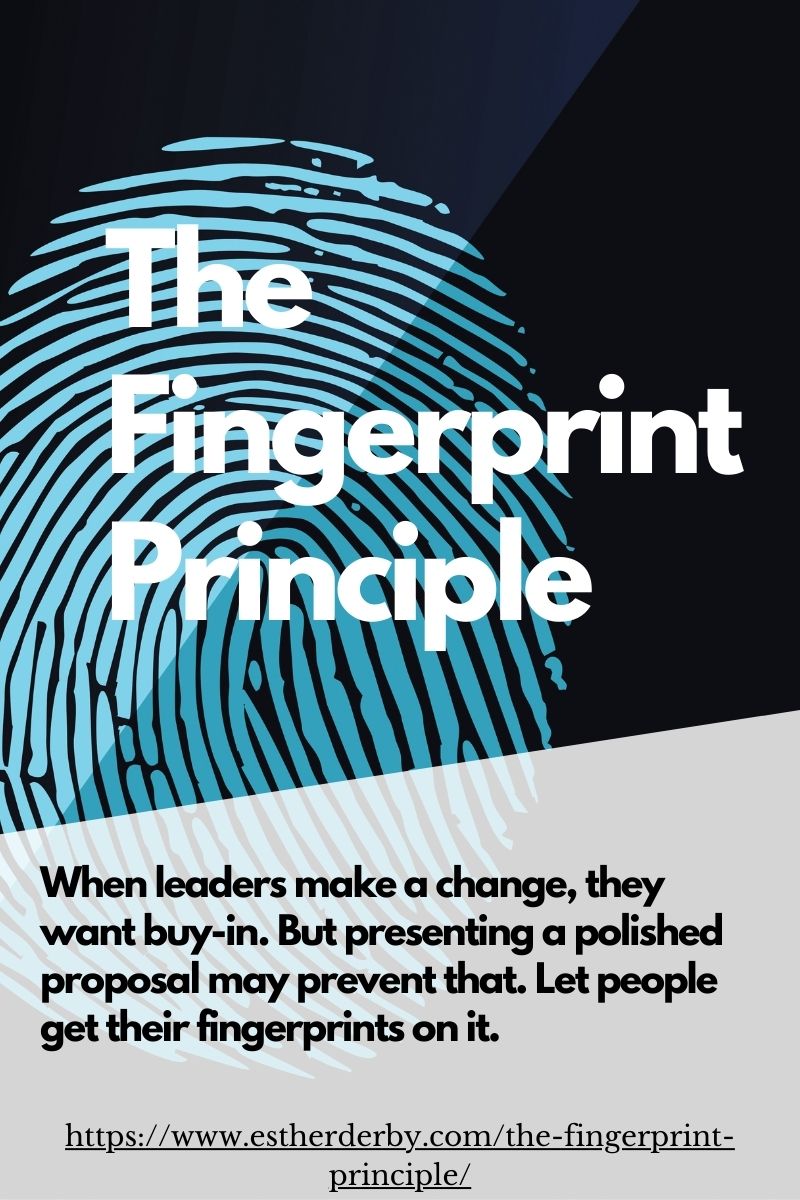Many managers believe that giving feedback is their job. And they’re right. But it is also everyone’s job to offer feedback when it comes to building working relationships.
A Story
Tom looked up to see Jonathan, who had just transferred onto the team, standing in the doorway to his office. Jonathan looked red and flustered. “What’s up, Jonathan? Looks like you’ve got something on your mind,” Tom said, waving Jonathan in and pulling up a chair for him.
A Problem Arises
Jonathan slumped into the chair. “You know I’ve been working with Danielle this week?” Jonathan began.

“Yes, how’s that going?” Tom asked. “Is she showing you the ropes?”
“I can’t work with her anymore!” Jonathan blurted out.
“Whoa,” Tom said. “That sounds pretty final. What brought that on?”
“She’s always eating cookies, and the crumbs get all over the keyboard. On Tuesday she left chocolate fingerprints on the table,” he said. “And yesterday she put greasy marks all over my printout.”
But Whose Problem?
“Have you talked to her about this?”
“Well, no,” Jonathan admitted. “But I wipe up after her, so she should get the hint.”
Tom took a breath. “If you haven’t talked to Danielle, how is she supposed to know you don’t like it when she eats cookies during your working sessions?”
“Anyone with a clue would know how rude it is to drop crumbs in the keyboard. Besides, giving feedback is your job,” Jonathan said.
“Yes, giving feedback is part of my job,” Tom said. “And it’s part of your job, too, Especially, when it comes to improving working relationships. You need to work this out with Danielle. I can coach you on what to say and how to say it. But, it is up to you to have the conversation. Triangulating–having me in the middle–won’t help.”
Jonathan crossed his arms and sank down in the chair. “All right. I’ll tell her,” he agreed grudgingly.
Tom and Jonathan discussed the outcome that Jonathan wanted and developed a script so he could practice what to say.
“Ready to go?” Tom asked.
“I guess so. I’ll ask her if we can talk right after lunch. She’s probably out buying cookies right now,” Jonathan replied.
A Triangulated Feedback Mess
Tom watched Jonathan walk out the door and sighed.
A year ago I would have fallen into the trap and talked to Danielle myself. Then she would have been hurt and angry. And it wouldn’t have helped Jonathan and Danielle work together—it would have made it worse.
Yes, it’s my job to provide feedback, Tom continued to muse. But it’s not my job to play middleman.
Tom had learned the hard way what happens when a manager delivers feedback for someone else. Last year at review time, Tom had asked everyone on his team to provide feedback for every other team member. He provided a form with a series of questions and a rating scale. At the bottom of the form was a space for additional comments. Tom had gathered up the feedback forms and consolidated the responses. I’ll have some solid information to provide people about how their peers view their skills, he’d thought. But the reviews didn’t go as well as Tom had hoped.
Martha had been mystified to learn her teammates rated her communication skills as poor. “What does that mean?” Martha had asked. “What can I change to do better?” Tom had made some general recommendations but couldn’t be specific.
Ted had been thunderstruck when he found out that Jenny had complained about an incident that had happened back in January. “I had no idea Jenny was upset about that. Heck! I hardly remember what happened. I wondered why Jenny had been cool toward me during that project, and this explains it. If she’d talked to me last January, I could have done something differently.”
Fred had summed up his review experience succinctly. “This feels like third grade—when someone’s upset, he goes to the teacher to tattle.”
The Clean Up
Rather than improving teamwork, Tom’s experiment in delivering secondhand feedback had bombed. He could feel the trust level drop as co-workers wondered who had said what. Everyone seemed to be waiting for the next knife in the back. Even the team members who had received positive feedback weren’t basking in the glow—”I’d rather someone thank me directly rather than filling in a stupid form,” one person said.
It had taken months to rebuild trust between team members. Tom had had to eat crow to do it.
After weeks of watching the team pull apart, Tom had called a special meeting.
“I made a big mistake,” Tom began. “I thought it would be helpful for the review process to gather your feedback for each other. But I see now that it wasn’t the right thing to do. I triangulated the feedback, rather than helping you offer feedback directly.
You guys aren’t talking and joking like you used to. It’s as quiet as a tomb around here. Most of you are barely speaking. And when you do, you sound guarded and careful about what you say.”
“It feels like my efforts at second-hand feedback, instead of helping, has destroyed trust,” he continued.
Tom had paused. “Do I have it about right?” The members of the team murmured their assent.
“OK, I blew it,” Tom said. “What can we do to move past this?”
Finally, Ted spoke up. “I was hurt and angry to hear that Jenny had complained about me.” Ted turned to Jenny. “Jenny, I really wish you had spoken to me directly.”
“I didn’t know what to say to you,” Jenny said looking at her notebook. “But next time you do something that bugs me, I’ll try.”
“Maybe we shouldn’t save up our feedback until the end of the year,” Fred offered.
The team continued to generate ideas on how to rebuild trust. Tom took an action item to arrange for a training session on peer-to-peer feedback.
The Happy Ending
It took time, but the team started chatting and joking again. And to Tom’s surprise, team members developed stronger relationships as they learned to handle the inevitable frictions directly and respectfully.
There were a few occasions when a team member came to Tom for advice on how to broach a sensitive topic. Tom continued to provide coaching and feedback based on his direct experience. Tom knew that in some rare instances, he’d need to be involved in a peer-to-peer issue—in the case of harassment, ethics, or safety. He knew someday he might have to step in when peer-to-peer feedback didn’t solve the issue.
A Resolve
Tom snapped out of his reverie. “These aren’t school kids, and I’m not the teacher,” he said to himself. “No more triangulated feedback for me.”
This article originally appeared in Better Software magazine. Updated 2020.







Great story! I had something like this happen as well. Peer-to-peer is crucial!
Hi, Esther! Thanks for your work on helping managers. I agree that 2nd hand feedback is less than ideal, but I think the article oversimplifies how difficult it is to get people into giving feedback.
In my 10+ years as manager, I’ve seen many cases where team members actually want you to solve the issues, not them, they don’t want that “direct confrontation” or “difficult conversation” with a colleague. It requires skills like knowing ways to give feedback, timing, etc. It’s difficult enough for managers, that hopefully have already some training. Imho for a team to do that you’ve already had to have built a safe space, which can take a long time.
Could you recommend resources about how to balance this (your feedback and peer2peer feedback), how to coach the team around giving and receiving feedback, etc…?
Thanks in advance!
Thanks for that article! Additionally I want to encourage everyone to put more effort in guiding people into the skill of asking for feedback. Instead of trying to improve giving feedback, which is prone to wreck havoc in peoples’ relationships, asking for feedback is more likely to lead to an expected outcome.